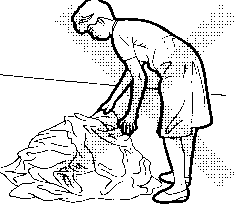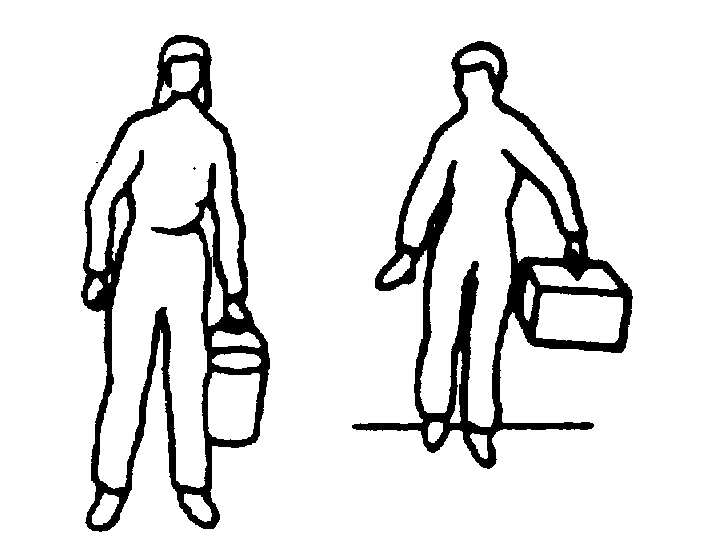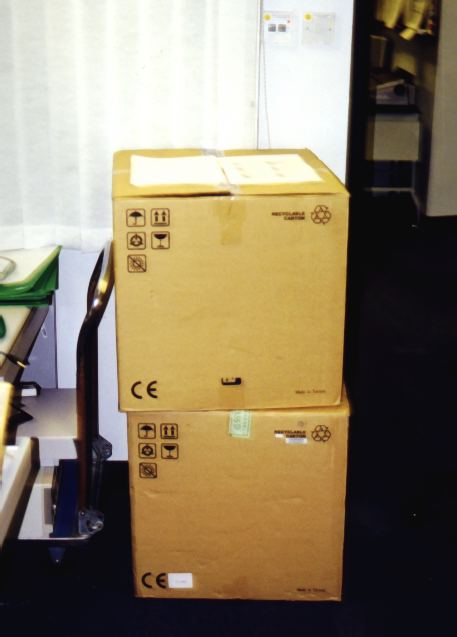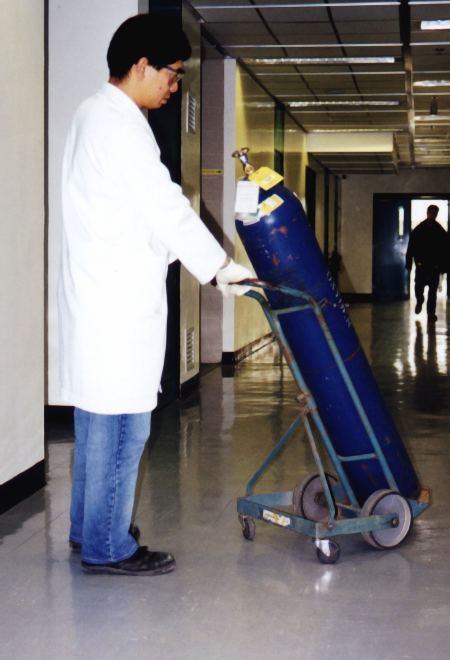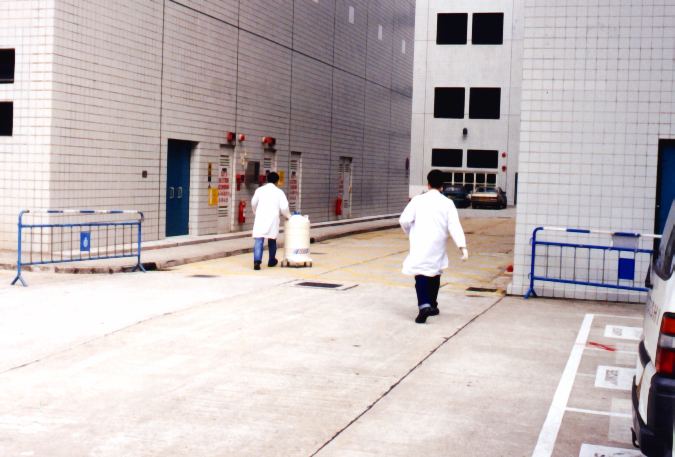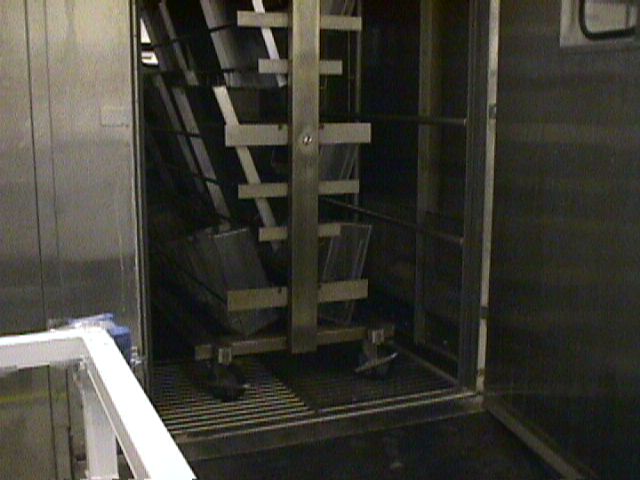Detailed assessment
Section B of the Form
Factors to Consider:
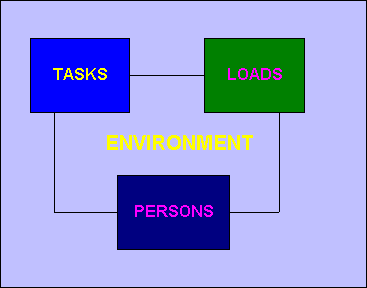
Weights and Forces
- Frequency and duration
- Position of the load
- Distance moved
- Characteristics of the load
Holding loads away from trunkThe risk of injury increases as the load is held further away from the front of the body. Holding a load at arm's length imposes about five times the strain experienced when holding the same load very close to the body. Picking up a load further away from the body can mean the handling of the object is not controlled. Accurately placing the load further away from the body will tire the muscles holding the load, due to the need for more careful control over its movement. |
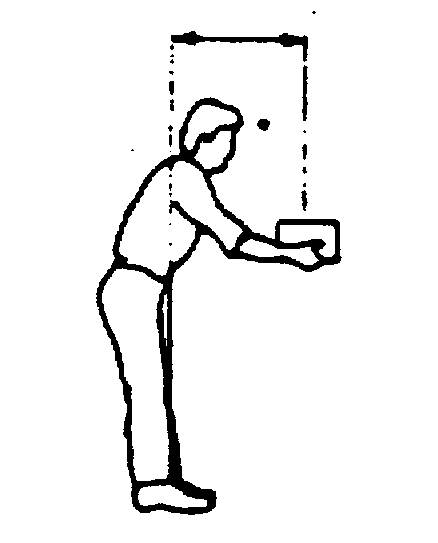 |
||||
Twisting the trunkThe risk of injury increases with the degree of body twist. The back is least able to take the stress caused by excessive twisting in repeated movements or prolonged posture. The combination of twisting and bending forward to handle a load represents a significant risk. The limits for lifting and lowering should be reduced if the handler twists to the side during the operation. As a rough guide, the limits should be reduced by about 10% where the hander twists through 45deg and by about 20% where the handler twists through 90deg. |
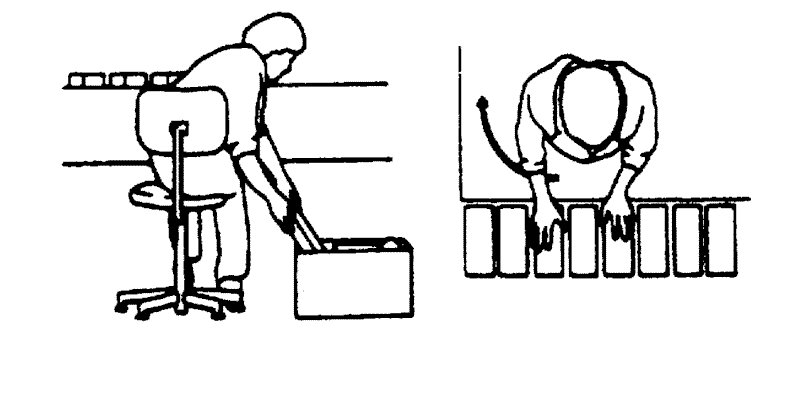 |
||||
Stooping or kneelingBending forward and handling the load below mid-thigh height The risk of injury increases the closer the load is to the ground. Bending forward to pick up loads from a low level creates strain, particularly on the lower back. Sideways bending and load handling with one hand The risk of injury increases with the degree of sideways bending to handle a load. Lifting and carrying loads in one hand places more stress on the side of the body. |
|
||||
Reaching upwards/ forward reachingReaching upwards and handling a load above shoulder height The risk of injury increases the higher the load is above shoulder height. To reach above shoulder height means the back is arched, and arms are acting as long levers. The load is more difficult to control.Lowering from this level to a level below mid-thigh height can require a change of grip. |
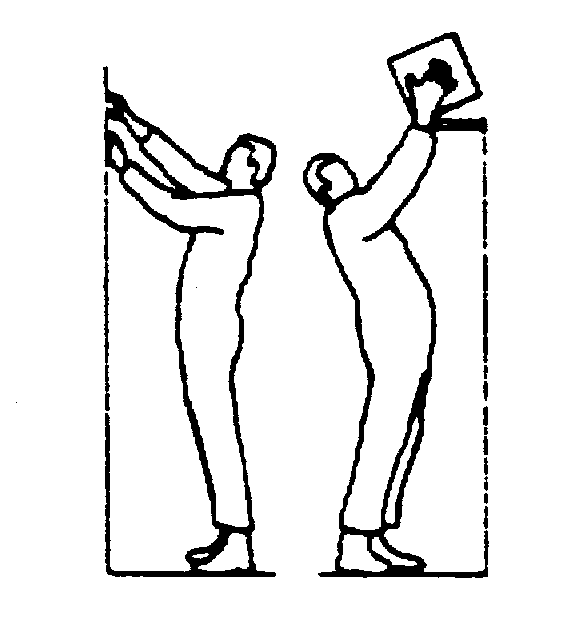 |
||||
Large vertical movement |
|||||
Long carrying distancesThe risk of injury increases with distances the load is carried. Carrying a load for an excessive distance increases muscle fatigue, particularly in the arms. This can affect an individual's ability to carry out other handling activities afterwards.It is assumed that the load is held against the body and is carried no further than about 10 meters without resting. It the load is carried out a longer distance without resting the limits may need to be reduced. |
|||||
Strenuous pushing or pullingThe risk of injury increases as the amount of force required to push and pull becomes greater. Initial forces to move an object are greater and involve higher risk than those required to keep an object moving. Pushing and pulling across the front of the body puts a twisting strain on the body which can lead to an increased risk of injury.For pushing an pulling loads: |
|||||
Repetitive handling/ lifting/ loweringFrequent lifting and lowering The limits for lifting and lowering are applicable for relatively infrequent operations - up to approximately 30 operations per hour - where:
If the operation is repeated more frequently, the limits should be reduced |
 |
||||
Insufficient rest or recovery |
|||||
A workrate imposed by a process |
|||||
Sudden jerky movementSudden or jerky movements The risk of injury increases with the amount of force used. Sudden or jerky movement can place unexpected loads on backs which are not prepared. For example, when a gardener jerks a heavy bag of potting mix or fertilizer on to a shoulder, or when a cleaner pulls a stuck vacuum cleaner cord and it comes away suddenly. |
Heavy |
The risk of injury increases as the weight of a load increases. Evaluating the risk of weight of the object needs to take into account:
As a guide the risk of back injury increases when loads over 16 kg are handled from a standing position. Generally, no single person should be required to lift, lower or carry loads over 55 kg.
The limits assume that the load is readily grasped with both hands and that the operation takes place in reasonable working conditions with the handler adopting a proper posture (straight back, bend knees, etc.) The risk of injury may be considered insignificant if the weight limits at the respective movement zones are not exceeded. On occasions, objects over 55 kg may be moved but not lifted, e.g. rolling a 200 liter drum. Where the load can be carried securely on the shoulder without first having to be lifted (as for example when unloading sacks from a lorry) a more detailed assessment may show that it is acceptable to exceed the limit. The limits takes into consideration the vertical and horizontal position of the hands as they move the load during the handling operation, as well as the height and reach of the individual handler. It will be apparent that the capability to lift or lower is reduced significantly when the load is held at arm's length or when the hands pass above shoulder height. If the hands enter more than one of the "movement zones" during the operation, the smallest weight limit should be used. The transition from one movement zone to another is not abrupt; an intermediate limit may be chosen where the hands are close to a boundary. Where lifting or lowering with the hands beyond the movement zones is unavoidable, a more detailed assessment should be made.
|
Bulky/ unwieldy |
The risk of injury increases as the size of the load becomes larger. The shape of the load can affect the way it can be held. Where a load's width (measured across the body) is more than 50 cm (wider than the distance between the knees) , there is an increased risk. When any dimension is more than 75 cm a greater risk is incurred. The risk is higher again if two dimensions are more than 75 cm. A large load may also block the view, when carried, and increase the chance of a person tripping.
|
Difficult to grasp |
The risk of injury increases with the lack of safe handholds on a load. Loads become more difficult to grip when they are smooth, slippery, greasy or wet. Extra grip strength will be needed to hold a load. This will be tiring for the person, and will increases the chance of the load being dropped. The absence of handholds due to awkward shape, or handholds in a difficult position, will affect a person's ability to hold the load.
|
Unstable/ uneven/ unpredictable |
The risk of injury increases with the level of instability and unpredictability. Loads with shifting contents make control of the load more difficult, and leads to sudden additional body stresses for which the person may not be fully prepared. A load where one side or one part is heavier than others will cause uneven muscular strain. This will be worse if the heavier part cannot be carried close to the body. |
Intrinsically harmful (e.g. sharp/hot) |
The risk of injury increases with:
These factors may cause injury, e.g. cuts or burns arising from the external state of the load. They may also impair grip and discourage good posture.
|
Handling a person or animal |
The risk of injury increases in relation to the unpredictable actions of the person or animals being handled. Handling persons who cannot assist, are unable to bear weight, or are uncooperative, will increase the risk of injury. Live animals being lifted or restrained may suddenly move or pull away, placing extra stress on the back. |
Require unusual capability/ strength, height, etc. |
The risk of injury increases with decreased physical ability. Young workers under the age of 18 are at greater risk than adult workers because they are still developing physically and their spine and other joints are more easily damaged. Loads over 16 kg represent significant risk to young workers. Occasional heavy manual handling may place extra demands on staff, who normally carry out lighter tasks, like office work. |
Hazard those with a health problem |
The risk of injury increases with health problem and with decreased physical ability. Employees returning to work after injury may not be able to perform at their normal level of work, Specific disabilities and illnesses, e.g. osteoarthritis and scoliosis, though not necessarily work related, may affect a person's ability in manual handling. Staff returning from an extended absence may not be as fit for physical work. |
Hazard those who are pregnant |
The risk of injury increases as pregnancy progresses. Hormonal changes can affect ligaments, increasing susceptibility to injury. Postural problems may increase as the pregnancy progresses. Difficulty in getting a load close to the body can be a particular problem. Care should also be taken for women who may handle loads following a return to work during the three months after childbirth. |
Call for special knowledge or training |
The risk of injury may increase where a greater degree of special skills, capabilities and/or knowledge is required. Some manual handling activities, e.g. patient handling, require very specific skills and knowledge to perform. |
Constraints on posture |
The risk of injury increases in relation to space constraints in handling. For space constraint to be a risk, it needs to impose a restriction on a person's handling ability. Restricted head room will promote a stooping posture, obstruction may increase the need for twisting or leaning, and narrow gangways will hinder maneuvering of bulky loads.
|
Slippery, uneven or unstable floors |
The risk of injury increases with great degree of floor slipperiness or unevenness. Uneven or slippery floors increase the likelihood of slips, trips or falls. They may also hinder smooth movement and create additional unpredictability. Uneven floor surfaces can hinder the safe use of trolleys.
|
Adverse climatic conditions: Hot/ cold |
The risk of injury increases with higher temperatures and humidity, colder temperatures or windy conditions. Higher temperature and humidity increase the total physical load on the body, which leads to more rapid fatigue. Perspiration on the hands may reduce gripping ability. Cold, windy conditions, particularly in the first part of the work period, may prevent muscles being properly warmed up. |
Poor lighting condition |
The risk of injury increases with lower levels of light or higher levels of glare. Low levels of light or high contrast between areas of bright light and deep shadows can aggravate tripping hazards. Concentration on the task may be reduced.
|
Strong air movements |
|
Obstructed passage/ visibility |
|
Variations in level |
The risk of injury increases with greater differences in floor level. The presence of steps or steep slopes adds to the difficulty of movement when handling loads, particularly when the load obscures a person's view. Carrying a load up or down a ladder will be difficult due to need to have a proper hold on the ladder.
|
